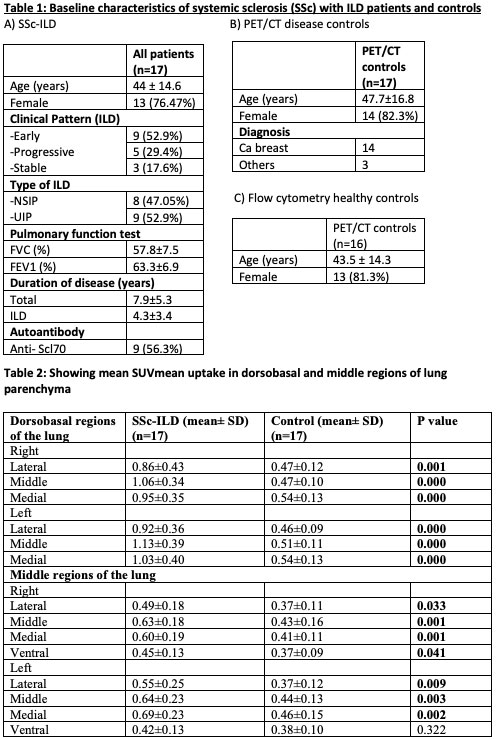Session Information
Session Type: Poster Session C
Session Time: 1:00PM-3:00PM
Background/Purpose: Interstitial lung disease (ILD) in Systemic sclerosis (SSc) is a major contributor of morbidity and mortality. CXCR4/CXCL12 axis has been implicated in the pathogenesis of pulmonary fibrosis. In this pilot study, we characterize the CXCR4 expression in lung parenchyma using 68Ga-Lympholeucin (CPCR4 trifluoroacetate) and peripheral white blood cells using PET/CT and flow cytometry.
Methods: In this cross-sectional study, we included SSc patients having active (n=14) and stable(n=3) ILD based on the duration, clinical and radiological progression, and FVC decline. 68Ga-Lympholeucin uptake in lung parenchyma was quantified in these 17 SSc-ILD patients and compared to the diseased controls without lung parenchymal involvement. Lung parenchyma was divided into 22 regions of interest (ROI) on PET/CT, drawn in the dorsobasal, middle and apical regions of the lung and individual areas were quantified for CXCR4 expression using SUVmean and compared to the controls. Flow cytometry was performed in 16 patients to quantify CXCR4 expression on CD4+ T cell, CD8+ T cell, CD14+ monocytes and CD19+ B cells, and compared with healthy controls.
Results: SSc-ILD patients underwent 68Ga-Lympholeucin PET/CT imaging showed significant SUVmean uptake in the lung parenchyma compared to controls. Most significant areas of uptake were noted in the dorsobasal regions of lung. Also, significantly higher CXCR4 uptake in the areas of ground glass (P< 0.001), reticulation (P< 0.001) and reticulation with architectural distortion (P< 0.001) opacities as compared to normal regions. Higher proportion of CD4 (83.83±7.99 vs 60.28±12.20; P< 0.001) and CD8 (67.67±14.4 vs 43.67±12.59; P=0.003) cells in SSc-ILD patients showed CXCR4 expression as compared to controls.
Conclusion: 68Ga-Lympholeucin PET/CT is a good imaging modality to quantify CXCR4 expression in lung parenchyma of SSc-ILD patients. Increased CXCR4 expression in the lung parenchyma using PET/CT and peripheral T cells could be used as a biomarker of disease activity and assessment of response to therapy.
In control patient, transaxial (I) and reformatted sagittal CT images (J) showing no abnormality on the bilateral lung fields with no abnormal tracer uptake in the lung fields on the fused PET/CT images (K,L).
To cite this abstract in AMA style:
Kopp C, Sharma S, Krishnaraju V, Prasad C, Singh J, Anand S, Minz R, Sood A, Sinha A, Basher R, Dhooria S, Dhir V, jain s. [68Ga]- CPCR4 Trifluoroacetate PET/CT Imaging of Chemokine Receptor CXCR4- Expression in Systemic Sclerosis Related Interstitial Lung Disease [abstract]. Arthritis Rheumatol. 2022; 74 (suppl 9). https://acrabstracts.org/abstract/68ga-cpcr4-trifluoroacetate-pet-ct-imaging-of-chemokine-receptor-cxcr4-expression-in-systemic-sclerosis-related-interstitial-lung-disease/. Accessed .« Back to ACR Convergence 2022
ACR Meeting Abstracts - https://acrabstracts.org/abstract/68ga-cpcr4-trifluoroacetate-pet-ct-imaging-of-chemokine-receptor-cxcr4-expression-in-systemic-sclerosis-related-interstitial-lung-disease/



